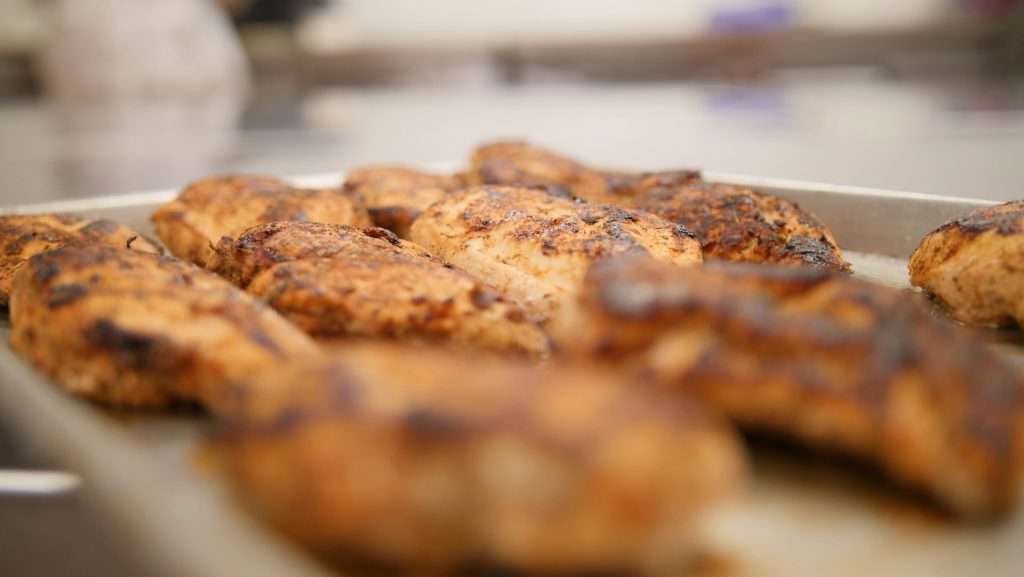Vet-Approved Homemade Chicken Dog Food Recipes for Happy, Healthy Dogs

Vet-Approved Homemade Chicken Dog Food Recipes. Feeding your dog doesn’t have to be complicated or intimidating, especially when you’re considering homemade options. Many pet parents adopt vet-approved homemade chicken dog food recipes to provide personalized nutrition while ensuring safety and health benefits.
It’s normal to worry about whether you’re meeting your dog’s dietary needs, but the good news is that with some guidance, you absolutely can. Packed with essential nutrients, chicken-based recipes can be a gentle yet satisfying choice for dogs, even those with sensitive stomachs.
For additional insight on handling dietary sensitivities, check out the best dog food for sensitive stomachs to ensure your recipe fits your pet’s needs perfectly.
Table of Contents
Why Homemade Chicken Dog Food?
When giving your dog the best care, their diet plays a pivotal role. Many dog owners choose homemade meals, particularly chicken-based recipes because they allow you to control every ingredient. It ensures you’re feeding your furry friend wholesome, nutrient-packed meals without the concerns of artificial additives or fillers often found in commercial dog food. Let’s explore more.
Benefits of Chicken for Dogs

Photo by Richard R
Chicken is more than just a kitchen staple—it’s a powerhouse of nutrition for your dog. It’s packed with lean protein, a key building block for muscle development. This is particularly beneficial for keeping your dog active and maintaining a healthy weight.
Key nutrients from chicken include:
- Essential amino acids: Support muscle growth and repair.
- Vitamin B6: Vital for energy metabolism and brain health.
- Phosphorus and selenium: Crucial for bone strength and immune function.
- Omega-6 fatty acids: Promote healthy skin and a shiny coat.
Unlike other meats, chicken is easy to digest, making it ideal for dogs with sensitive stomachs. If you’re considering adding variety to your dog’s diet, check this guide on homemade dog meal recipes for wholesome ideas.
If you need further insights into the nutritional value of chicken, explore this resource on the benefits of chicken in dog food.
Risks of Store-Bought Dog Food
While convenient, store-bought dog food often carries hidden risks. Many commercial brands use artificial preservatives, food dyes, and flavoring additives, potentially jeopardizing your dog’s long-term health. Over time, these ingredients might cause allergies, digestive problems, or even lead to chronic diseases.
Some drawbacks of commercial dog food include:
- Lower Quality Ingredients: Many brands rely on meat by-products or fillers like corn and soy instead of accurate protein sources.
- Harmful Additives: Look out for BHA, BHT, and ethoxyquin—preservatives linked to adverse health effects.
- Contamination Risks: Certain kibble brands have been recalled for bacterial contamination or containing harmful substances.
By preparing homemade chicken dog food, you bypass these risks entirely. You gain complete control over ingredient quality and ensure your dog gets the freshest meal possible. If your dog leads an active lifestyle, consider these energy-packed recipes to keep them fueled and happy.
Keep your dog’s food fresh and tailored to their needs, and you’ll likely notice a significant boost in their health and happiness!
Key Nutritional Needs for Dogs
Understanding your dog’s core nutritional needs is crucial when creating balanced homemade meals. Addressing these needs ensures their overall health, energy, and longevity. This section breaks down the essentials so you can confidently approach homemade dog food preparation.
Macronutrients: Protein, Carbohydrates, and Fats

Photo by Mathew Coulton
Macronutrients form the foundation of your dog’s diet. Protein, carbohydrates, and fats each play a vital role in keeping your pet healthy and active.
Proteins: These are at the heart of a dog’s diet, as they provide essential amino acids for muscle growth, repair, and daily energy needs. Lean meats like chicken, turkey, and fish are excellent sources. For further understanding of planning protein-rich meals, check the guide on meal planning for dogs with special diet needs.
- Carbohydrates: Dogs require fewer carbs than humans, but they’re still a valuable energy source. Ingredients like
brown rice, sweet potatoes, and peas are great options. They’re easy to digest and ideal for homemade dog food.
Fats: Healthy fats provide energy and support vital functions like maintaining a shiny coat and healthy skin. Consider adding a splash of olive oil or including fatty fish like sardines for omega-3s and omega-6s. Ensure fats are balanced to avoid weight gain.
Striking the right macronutrient balance is key. A typical canine meal might allocate about 50% protein, 25% carbs, and 25% fats, but exact ratios depend on your dog’s age, weight, and activity level.
Vitamins and Minerals
Dogs require a variety of vitamins and minerals to maintain optimum health. Here are some key nutrients and where to find them:
- Vitamin A: Found in carrots and sweet potatoes, it supports eye health and immunity.
- Vitamin D: Helps with calcium absorption and bone strength. You can include fish like salmon.
- Calcium: Critical for strong bones and teeth. Find this in crushed eggshell powder or dairy (in moderation).
- Iron: Essential for red blood cells to transport oxygen. Sources include liver and cooked leafy greens.
- Zinc and Selenium: Support the immune system and skin health. Found in pumpkin seeds and certain meats.
Introducing a mix of these ingredients into your recipes is essential to ensure a variety of nutrients. If you’re concerned about incomplete nutrition, learn how to spot nutritional deficiencies in your dog for peace of mind.
Consulting a Veterinarian
Even though crafting meals at home can feel empowering, a veterinarian’s input is essential. Why? Dogs have unique nutritional requirements that vary by breed, age, weight, and health conditions. Even with the best intentions, homemade recipes may lead to nutrient imbalances or deficiencies over time.
A vet can:
- Help you tailor recipes to suit your dog’s specific needs.
- Calcium or omega fatty acids should be recommended to round out the diet.
- Advise on portion sizes and feeding frequency, ensuring a healthy weight.
For more feeding tips and guidance, visit How to Create a Dog Feeding Schedule.
Taking these steps will keep your dog happy and healthy and save you from unexpected long-term health issues related to improper diet.
Vet-Approved Chicken Dog Food Recipes
Creating nutritious and balanced chicken-based meals for your dog at home can be a game-changer for their health and well-being. This section will walk through simple recipes and key tips to ensure every bite is flavorful and nutritious. These vet-approved ideas are designed to cater to various dietary needs, all while being easy to prepare.
Simple Chicken and Rice Recipe

Photo by Nastya Korenkova
Chicken and rice is a classic staple meal for dogs. It works wonders for dogs recovering from an upset stomach but is equally great as a regular meal. This dish is simple yet wholesome and can be adjusted based on your dog’s size and activity level.
Ingredients:
- 1 cup boneless, skinless chicken breast (cooked and shredded)
- 1 cup white or brown rice (cooked)
- Optional: A splash of chicken broth (low sodium) for flavor
Directions:
- Cook the rice according to the package instructions. Let it cool.
- Boil or grill the chicken breast, ensuring it’s thoroughly cooked. Shred it into small, dog-friendly pieces.
- Combine the chicken and rice in a 2:1 ratio (two parts chicken to one part rice) in a bowl.
Portion Sizes:
- Small dogs: ~½ to 1 cup per meal
- Medium dogs: ~1½ to 2 cups per meal
- Large dogs: ~2½ to 3 cups per meal
For those seeking insights into whether homemade meals fit their pet, explore Are Homemade Diets for Dogs Safe and Worth Trying?
Chicken and Vegetable Medley
Mixing chicken with vegetables like carrots and spinach for a well-rounded meal can enhance flavor and nutrient diversity. Adding vegetables ensures your pup gets essential vitamins and minerals.
Ingredients:
- 1 cup cooked chicken (shredded, skin removed)
- ½ cup steamed carrots (diced)
- ½ cup chopped spinach (lightly steamed)
- Optional: ½ tsp turmeric powder for an anti-inflammatory boost
Directions:
- Cook the chicken thoroughly (boil, bake, or grill).
- Steam the carrots and spinach until soft but not mushy.
- Combine all the ingredients in a bowl and mix well.
Dogs will appreciate the vibrant mix of nutrients and textures. Carrots provide Vitamin A for eye health, while spinach adds iron and antioxidants. For more chicken-based recipes, visit Best Dog Food for Boxers, which features chicken and veggie medley ideas.
Incorporating Supplements
Homemade meals, while wholesome, may lack certain essential nutrients. Vitamins and minerals are critical for balanced nutrition. Here’s a quick guide on supplements you might need to include:
Common Add-Ons:
- Fish Oil: Excellent source of omega-3 fatty acids for a shiny coat and joint health.
- Calcium: Vital for bone health; crushed eggshell powder is a great natural option.
- Vitamin E: An antioxidant that supports immune function.
How to Include Them:
- Mix a teaspoon of fish oil into the meal once a day.
- Add a small pinch (1/4 tsp) of powdered calcium or eggshell to the mix.
- Consult your vet before starting any supplement regimen to ensure proper dosages based on your dog’s weight and specific needs.
For more information on tailoring meals to your senior pup or specific dietary requirements, check out Senior Dog Food.
Preparation and Storage Tips
Making homemade chicken dog food offers many benefits, but ensuring proper preparation and storage is equally important. These factors influence nutritional quality and keep your pup safe from foodborne illnesses. Let’s break down the essentials.
Cooking Methods
When cooking chicken for your dog, preserving nutrients is key. Cooking processes like boiling or baking are excellent choices, as they maintain the chicken’s nutritional integrity without adding unnecessary fats or oils.
- Boiling: This is a gentle yet effective method. Boiling chicken retains its natural flavor and nutrients while eliminating harmful bacteria. Use plain water—avoid adding salt or oils, as they aren’t suitable for dogs.
- Baking: Baking is great for larger batches. Place chicken breasts on a baking sheet and bake at 375°F until fully cooked. Because you’re not submerging it in water, crucial nutrients won’t leach out.
Be cautious with frying or grilling. While these methods are tasty for us, they often introduce grease, charred bits, or harmful compounds that aren’t ideal for your dog.
Safe Storage Practices
Proper storage starts with how you handle the food after cooking. Incorrect storage can quickly cause spoilage or contamination, so taking a few protective steps makes all the difference.
Here are some key tips to keep in mind:
- Extraordinary Food Promptly: After cooking, let the chicken cool completely before storing it. Never place hot food directly into the refrigerator—it can raise the internal temperature and encourage bacterial growth.
- Use Airtight Containers: Store portions in BPA-free airtight containers. This prevents cross-contamination and locks in freshness.
- Refrigeration: Homemade meals should be refrigerated immediately and used within 3-5 days. For tips on keeping homemade meals fresh, check out this guide on The Farmer’s Dog tips for storage.
- Freezing for Longevity: If you’re prepping food in bulk, freezing is your best friend—label containers with the date to track freshness. Most dog food is kept in the freezer for up to 3 months, as detailed in this resource.
While serving, ensure leftovers are always refrigerated. Monitor the food for unusual smells or textures—a sign it’s past its prime.
Without proper preparation and storage, even the healthiest recipes could lose their nutritional edge or put your pup’s health at risk. And if you’re looking for additional energy-boosting ideas, visit Recipes for Active Dogs.
With these tips, you’ll feel confident that mealtime is as safe as nutritious!
Common Mistakes to Avoid
Even the most well-meaning dog owners can stumble into some common pitfalls when preparing homemade chicken food recipes. Understanding these mistakes can help you deliver a tasty dish and a genuinely balanced, nutritious meal for your furry friend. Let’s tackle two frequent errors many pet parents make.
Overuse of Single Ingredients: Why Variety is Key

Photo by Jessica Lewis ????
When creating homemade meals, it’s common to lean heavily on one ingredient, like chicken. After all, it’s a safe, protein-rich option adored by dogs. But here’s the catch—dogs, like humans, thrive on a varied diet. Over time, sticking to a single ingredient can lead to nutritional deficiencies or food sensitivities.
Why does variety matter?
- Different ingredients provide unique nutrients. For example, while chicken offers protein, it lacks other essentials like omega-3 fatty acids found in fish.
- A monotonous diet may cause your dog to develop food allergies. Over-reliance on chicken, for instance, can lead to sensitivities, making meal options narrower over time.
To avoid this pitfall:
- Incorporate vegetables, such as carrots and spinach, for added vitamins and minerals.
- Rotate proteins like fish or turkey to ensure a spectrum of amino acids.
- Experiment with healthy grains like quinoa or oats to provide additional energy.
If variety sounds intimidating, check out the benefits of diversified homemade dog meals for inspiration.
Skipping Supplements: The Risks of Ignoring Essential Add-ons
Homemade dog food can be freshly cooked, nutrient-dense, and free from harmful additives, but it doesn’t automatically cover all dietary bases. That’s where supplements step in. Skipping these can lead to serious gaps in your dog’s nutrition.
What could go wrong without supplements?
- Calcium deficiency: Dogs need calcium for strong bones and teeth, but it’s rarely enough in homemade meals unless you add it intentionally. Crushed eggshell powder is one natural fix.
- Omega-3 and omega-6 imbalance: While chicken is rich in omega-6 fatty acids, the absence of omega-3s from fish oil or fatty fish can lead to poor skin and coat health.
- Vitamin and mineral shortages: Critical micronutrients can be missing, from Vitamin E to zinc. Improper balance may cause long-term health concerns, from weakened immunity to delayed wound healing.
To sidestep these risks:
- Add a daily fish oil supplement for essential fatty acids.
- Include small amounts of organ meats like liver, a natural source of vitamins A and iron.
- Use a reputable multivitamin for canines to fill any remaining gaps.
Striking the right balance requires a bit of planning. If you’re unsure, this resource on avoiding homemade food mistakes can guide you on what to include. Once your base recipe is solid, consult your vet to tailor a supplement plan that matches your dog’s unique needs.
Avoiding these mistakes will bring you closer to crafting meals that are delicious but also complete and balanced for your dog.
Additional Resources
Looking to expand your knowledge and make homemade cooking even more exciting for your dog? These resources can help you understand canine nutrition and create special treats that your furry friend will love.
Recommended Reading on Dog Nutrition

Photo by Maarten van den Heuvel
Understanding your dog’s dietary needs is the first step toward preparing balanced, vet-approved meals at home. Feeding your dog isn’t just about filling their bowl; it’s about fueling their body and supporting their health. Learn about addressing common dietary issues, like sensitive stomachs, and how to personalize your dog’s diet for optimal health. Check out this comprehensive guide on the best dog food for sensitive stomachs to deepen your understanding of how nutrition plays a role in canine wellness.
Easy Homemade Treats
Preparing meals is excellent, but don’t forget about treats—they’re not just snacks but little expressions of love! Why not create customized treats if you want to make something extra special for your pup? From birthday cakes to everyday goodies, crafting your treats ensures they’re free from harmful ingredients or excess calories in many store-bought options.
One easy starting point is this delightful dog cake recipe, which can be personalized using dog-friendly ingredients like pumpkin and peanut butter. It’s fun to prepare and perfect for celebrating moments big and small in your dog’s life.
Frequently Asked Questions (FAQ)
Pet parents often have plenty of questions when preparing homemade chicken dog food. From ensuring nutritional balance to avoiding common pitfalls, let’s address some of the most frequently asked queries to make this journey smooth. Read on to find helpful tips for homemade meals that are both safe and satisfying for your furry friend.
Is Homemade Chicken Dog Food Safe for All Dogs?
Homemade meals can be incredibly beneficial when prepared correctly, but they’re not universally safe for all dogs. Some dogs have specific dietary restrictions, allergies, or health concerns requiring specialized feeding plans. Consulting your veterinarian is always a good idea before switching to homemade recipes.
Keep in mind:
- Puppies need more calcium and phosphorus for bone development.
- Dogs with conditions like kidney disease may need specific low-protein diets.
- Active breeds require higher calorie meals to match their energy needs.
For more tailored advice, consider exploring meal planning for special dietary needs, which provides insights into customizing meals.
Can I Only Use Chicken in My Dog’s Meals?
No, sticking to chicken could limit your dog’s access to essential nutrients in other proteins and ingredients. While chicken provides excellent lean protein, a balanced diet should also include vegetables, healthy fats, and occasional variety in protein sources, like fish or turkey. Adding diverse ingredients ensures your dog gets all the essential nutrients.
Check out these additional balanced homemade recipes to create varied meals without compromising nutrition.
Do Homemade Recipes Require Supplements?
Yes, supplements can fill nutritional gaps in homemade meals. Essential nutrients like calcium, omega-3 fatty acids, and specific vitamins may not always be adequately present, even in the best homemade recipes.
Consider these common additions:
- Fish oil: For a shiny coat and healthy joints.
- Crushed eggshells: A natural calcium source.
- Multivitamins: Tailored for dogs to meet their unique needs.
For guidance on supplements, consult your vet or learn tips for avoiding nutrition gaps in homemade food.
How Long Can I Store Homemade Chicken Dog Food?
Safe storage is key to maintaining food quality and keeping your dog healthy. Homemade meals should be refrigerated and consumed within 3-5 days. For more extended storage, freeze in portioned containers for up to three months. Always label containers with dates to track freshness.
If you’re unsure about the best storage practices, check out this detailed article on storing homemade dog food.

Photo by RDNE Stock project
Can I Serve Food Directly After Cooking?
While fresh food is best, it’s essential to let meals cool before serving to avoid burning your dog’s mouth. Cooling also allows the flavors to settle, making meals safer and more appealing to your pet. When reheating, ensure food is lukewarm rather than steaming hot.
For more on homemade recipes that dogs adore, explore how to make chicken and rice for dogs, a classic staple meal.
How Do I Know If My Dog Likes These Meals?
Dogs are often expressive about their preferences. If they’re excited at mealtime and finish their bowl, that’s a green light! However, keep an eye on digestion—any sign of upset stomach, vomiting, or irregular stools may indicate the need to adjust the recipe.
For a personalized approach to creating meals your dog will love, look into vet-approved homemade dog food recipes for taste and nutritional balance.
By addressing these FAQs, you’ll be better equipped to prepare healthy, delicious meals for your dog confidently.
Conclusion
Homemade chicken dog food recipes offer a rewarding way to deliver quality nutrition tailored to your dog’s needs. You can ensure meals are balanced and safe by using fresh, wholesome ingredients and consulting with your vet.
Taking the time to prepare meals responsibly strengthens the bond with your furry friend and supports their health and happiness. If you’re new to crafting tailored diets, explore our nutrition tips for expert guidance and ideas.
Your dog’s well-being is in your hands—start small, stay informed, and watch your pup thrive!






